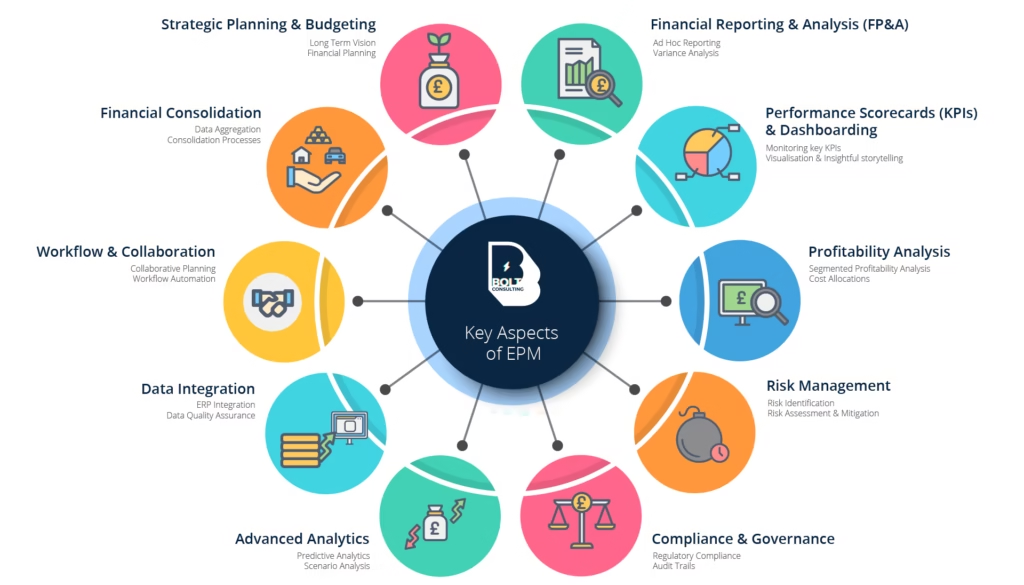Navigating Growth
The Dynamic Landscape of Global Enterprise Performance Management (EPM)
in 2024
The Evolving Landscape
In the swiftly evolving sphere of Enterprise Performance Management (EPM), the horizon is adorned with promising shades of growth. Projections indicate a robust Compound Annual Growth Rate(CAGR) of 9.5% for the global EPM market during the forecast period spanning 2024 to 2029.
Expected to surge from £5.94 billion in 2024 to a formidable £9.35 billion by 2029, this trajectory underscores the sector’s resilience and burgeoning significance.
A notable catalyst propelling this upward trend is the escalating adoption of cloud-based EPM solutions on a global scale. As organisations increasingly turn to cloud deployment models, the market is witnessing a surge in traction, redefining the dynamics of performance management strategies across industries.

Before we delve into the details, let’s clarify what we mean by EPM. Bolt Consulting defines EPM as a comprehensive suite of tools and methodologies designed to optimise organisational performance. Here, we provide a summary of the integral components within an EPM solution, tailored for businesses seeking enhanced efficiency and strategic alignment.

Strategic Planning and Budgeting:
- Long-term Vision: Establishing overarching goals in alignment with the organisational mission.
- Financial Planning: Crafting detailed financial plans and forecasts, adapting budgets in response to evolving conditions.
Financial Consolidation:
- Data Aggregation: Collecting financial data from diverse sources, including business units, departments, or subsidiaries.
- Consolidation Processes: Integrating and reconciling financial information to generate accurate, comprehensive consolidated reports.
Financial Reporting and Analysis:
- Ad Hoc Reporting: Generating on-demand reports for specific inquiries or analyses.
- Variance Analysis: Identifying and analysing discrepancies between planned and actual financial performance.
Performance Scorecards and Dashboards:
- Key Performance Indicators (KPIs): Defining and monitoring critical metrics to gauge organisational performance.
- Visual Representations: Presenting performance data through user-friendly scorecards and dashboards for rapid insights.
Profitability Analysis:
- Product, Customer, and Service Profitability: Evaluating the profitability of specific products, customers, or services.
- Cost Allocation: Allocating costs accurately to assess profitability at various organisational levels.
Workflow and Collaboration:
- Collaborative Planning: Facilitating teamwork across different departments for planning and performance initiatives.
- Workflow Automation: Streamlining processes through automated workflows to enhance coordination and efficiency.
Data Integration:
- ERP Integration: Connecting with Enterprise Resource Planning (ERP) systems to ensure a unified and accurate flow of data.
- Data Quality Assurance: Verifying the accuracy and consistency of integrated data for reliable reporting and analysis.
Advanced Analytics:
- Predictive Analytics: Utilising predictive modelling to forecast future performance based on historical data.
- Scenario Analysis: Assessing the impact of different scenarios on financial and operational outcomes.
Compliance and Governance:
- Regulatory Compliance: Ensuring adherence to industry regulations and financial reporting standards.
- Audit Trails: Maintaining detailed records of changes and activities for compliance and governance purposes.
Risk Management:
- Risk Identification: Identifying potential risks that could impact organisational performance.
- Risk Assessment and Mitigation: Evaluating and addressing risks to minimise their impact on strategic objectives.
Leaping into the Future
In today’s dynamic business landscape, the integration of Artificial Intelligence (AI) has become ubiquitous in shaping the effectiveness of EPM processes. AI seamlessly weaves its capabilities into strategic planning, leveraging advanced algorithms for more accurate forecasting and data-driven decision-making.
From automated data aggregation to AI-driven risk management, businesses now harness the power of intelligent technologies to navigate complexities. In the realm of EPM, AI doesn’t merely enhance efficiency; it transforms how organisations plan, analyse, and adapt.
As we look into the future of business excellence, the pervasive influence of AI underscores the transformative potential embedded in EPM solutions, propelling enterprises towards unparalleled heights of performance and competitiveness.
In conclusion, an EPM solution offers a comprehensive framework for businesses to align strategic goals with operational activities, fostering efficient planning, monitoring, and decision-making across various facets of the business. Explore how our EPM solutions can elevate your organisational performance and drive strategic success.

Insights & Drivers in 2024
In the rapidly changing market for Enterprise Performance Management (EPM), a landscape of significant growth emerges. Projections indicate a robust Compound Annual Growth Rate (CAGR) of 9.5% for the global EPM market during the forecast period from 2024 to 2029. Expected to increase from £7.53 billion in 2024 to a substantial £11.86 billion by 2029, this trajectory underscores the sector’s resilience and growing significance.
A key driver fuelling this upward trajectory is the increasing adoption of cloud-based EPM solutions globally. As organisations progressively opt for cloud deployment models, the market witnesses a surge in traction, reshaping the dynamics of performance management strategies across industries.
“Projections indicate a robust Compound Annual Growth Rate (CAGR) of 9.5% for the global EPM market during the forecast period from 2024 to 2029.
Expected to increase from £7.53 billion in 2024 to a substantial £11.86 billion by 2029, this trajectory underscores the sector’s resilience and growing significance.”
Segmentation as the Key to Precision
The EPM market distinguishes itself through meticulous segmentation, considering factors such as deployment preferences (on-premise or cloud), enterprise size (small and medium versus large enterprises), end-user industries, and geographical landscapes. This nuanced approach recognises the diverse needs of enterprises, providing tailored solutions for optimal performance management.
Strategic Priorities: A Matrix of Transformation
Amidst this growth narrative, enterprises are establishing distinct priorities to strengthen their position in the competitive EPM landscape. At the forefront are imperatives such as transformative initiatives, core function enhancements, adept risk management, and the cultivation of growth avenues, all underpinned by stakeholder engagement and value creation.
Technology’s Pervasive Role: From Automation to Insight
Finance leadership and management are orchestrating a paradigm shift by leveraging technology to automate critical processes. From reporting and planning to the intricate details of financial closures, the emphasis is on enhancing speed, efficiency, and accuracy. While the overarching strategy lies with the C-Level and Director Finance community, the pulse of these processes is most keenly felt and driven by the Controller Finance community. Their strategic approach to technology adoption becomes paramount in navigating the intricate challenges of EPM.
Empowering FP&A Through Automation
Within this ecosystem, the Financial Planning and Analysis (FP&A) Finance Community assumes a pivotal role. Automation and technological advancements become indispensable for FP&A professionals as they navigate core processes. Beyond these foundational tasks, the translation of efforts into actionable analytics and insights necessitates a continuous reliance on technology to meet evolving business demands.
As we traverse the anticipated growth in the EPM market, the synergy between strategic leadership, technological innovation, and the nuanced expertise of finance professionals becomes the linchpin for organisations aiming not just to keep pace but to thrive in this dynamic landscape.
Bolt Consulting in the World of EPM
In the complex world of Enterprise Performance Management (EPM), Bolt Consulting steps in as a pragmatic guide, offering robust advisory and thought leadership to steer organisations through their EPM solution journey. With a gritty grasp of the ever-shifting market dynamics, our team is poised to help businesses navigate the nuances of EPM adoption.
Through no-nonsense analysis and practical insights, we ensure that organisations not only keep up with the projected growth but turn it into a catalyst for real change. As industry leaders, Bolt Consulting equips businesses to make tough decisions, employing technology for efficient automation and crafting a tailored roadmap that aligns with their specific needs.
Whether you’re a heavyweight enterprise looking to streamline core functions or a smaller player eyeing strategic growth, Bolt Consulting is the seasoned companion to unlock the raw potential of EPM solutions.
We create solutions tailored to your individual needs.
True Thought Leadership
Our team embraces innovation, challenging norms and contributing new ideas to propel your business forward. Thought leadership isn’t just a buzzword; it’s a commitment to excellence, building a strong foundation for individual and organisational success.
Unbiased Advisory
We take pride in delivering impartial and objective guidance, we prioritise your best interests, offering transparent and impartial advice that aligns with your unique needs and goals. You can be confident that our recommendations are based on what is right for you, ensuring a reliable and trustworthy partnership.
A Partner Through the Entire Journey
Count on us as your trusted delivery partner in your solution lifecycle. We take great pride in our commitment to delivering services with the utmost integrity and reliability. Our dedicated team of experts is here to provide you with transparent and impartial guidance, ensuring your delivery needs are met seamlessly.
Upcoming Content…
In the coming weeks, we will add further content with insights into the world of EPM. Stay tuned for more value-add content and thought leadership from our seasoned experts.

Don’t forget to add us to your safe list — To ensure you continue to receive our valuable insights and content, add boltconsulting.co.uk to your safe list.
Who we’ve helped.
… Just a selection of clients and companies who’ve benefited from the power of what we can do. Want your company to be featured here too? Get in touch.






